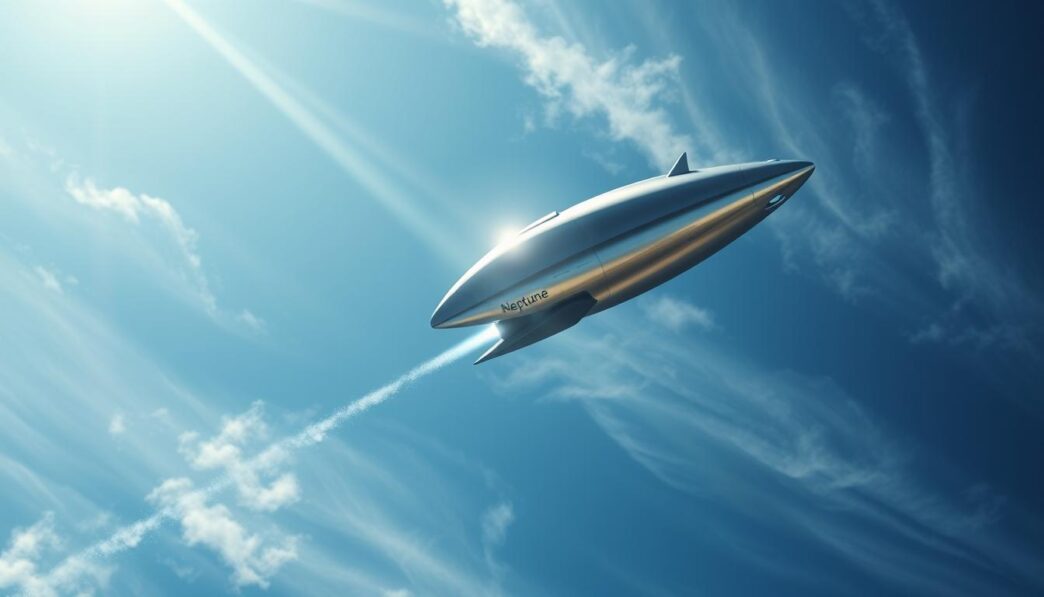Space exploration has reached a new high with Spaceship Neptune’s test. This event is not just a step forward but shines as a beacon of progress. The Space Perspective team’s hard work led to Development Flight 2. This test took Spaceship Neptune up to about 100,000 feet, through over 99% of Earth’s atmosphere. It lasted six hours and ended with a perfect splashdown1. These achievements hint at a new era of space travel. They promise exciting possibilities for future civilian explorers.
Key Takeaways
- Spaceship Neptune reached an impressive altitude of approximately 100,000 feet12.
- Over 1,800 adventurers have secured their tickets, priced at $125,000, to experience space aboard this pioneering vehicle12.
- The Space Perspective’s commitment is backed by a $100 million investment, fueling the journey to commercial space travel12.
- Human flights are targeted to begin in 2025, with commercial operations following in 2026, setting Space Perspective on a trajectory to lead the commercial space travel market12.
- The test flight’s success was partly due to the SpaceBalloon™ technology, achieving safe ascents to edge-of-space altitudes1.
Delving into Spaceship Neptune’s Revolutionary Technology
Spaceship Neptune’s test flight was a big win for space tourism. It showed amazing achievements in spacecraft testing. It also highlighted how it could change the future of space exploration. As we dig deeper into this ship’s test results, we discover new technologies. These could change how we go to space and what we do there.
The Dawn of a New Era in Space Tourism
Spaceship Neptune combines luxury with adventure. It gives passengers a stunning 360-degree view, seeing nearly 450 miles around3. Its design offers wide visibility. This improves the travel experience and sets new high standards for space journeys.
Revolutionizing Access to the Final Frontier
Spaceship Neptune orbits Earth at 30 kilometers, closer than usual space limits3. This method makes space more reachable, even for those who are not astronauts. It’s a big step forward in space exploration.
Innovative Thermal Control and Pressure Systems
Spaceship Neptune has a top-notch thermal control system. It deals with the harsh temperatures of space. Its pressure resistance systems are also superior, thanks to a unique balloon capsule design3. This means passengers stay safe and comfortable. They can enjoy their space journey without the usual discomforts.
The recent test success of Spaceship Neptune is a major milestone. It’s not just about testing a spacecraft, but lighting the way for future exploration. Every spacecraft that goes past our atmosphere gets us closer to making the cosmos our next adventure spot.
Redefining the Launch: MS Voyager’s Role in the Historic Test
The successful launch of Spaceship Neptune marks a high point in space exploration efforts. The MS Voyager played a key role in this achievement with its unique four-roller system. This system helped lift the SpaceBalloon™. This breakthrough puts Space Perspective at the forefront of marine spaceport technology worldwide, highlighting the success of the test.
The MS Voyager did more than just support Spaceship Neptune’s launch. It also established new standards for future space missions. The test results of this celestial vessel are not only promising but also revolutionary. The MS Voyager’s contribution to this historic event shows a huge advancement in space travel management and execution.
| Aspect | Details |
|---|---|
| Launch Date of Spaceship Neptune | Marking of a new era in space exploration with advanced on-board systems designed to enhance astronaut and cosmonaut safety4. |
| Spaceship Capacity | Can accommodate 8 passengers, fostering an intimate yet groundbreaking space travel experience5. |
| Ticket Cost | At $125,000, it’s positioned as a more accessible option compared to other commercial space travel services5. |
| Global Tickets Sold | Over 1,800, indicating a strong market interest and confidence in the viability of commercial space tourism5. |
| Technological Innovation | Utilization of a 3D printer on-board for creating vital components showcases innovative problem-solving approaches6. |

In conclusion, the MS Voyager was essential in testing Spaceship Neptune. It marks a notable moment in space exploration history. Its role in this significant event not only highlights the mission’s success but also paves the way for future challenges in space travel.
Inside the Largest Capsule: Spaceship Neptune’s Test Success
The recent test of Spaceship Neptune marks a major step in space exploration. Its successful six-hour flight hit a height of about 100,000 feet7. Named Excelsior, this ship shows what future spacecraft could do and hints at space travel for everyone.
The Pinnacle of Spacecraft Engineering
Spaceship Neptune’s capsule was designed with safety and comfort in mind. It can hold up to eight people, offering them an amazing view from the biggest windows ever in a spacecraft7. This isn’t just a test; it’s a breakthrough in space travel.
Breakthroughs in Astronaut Comfort and Safety
Improvements in comfort and safety stand out in this test. It aims for travelers to not just travel, but enjoy unparalleled comfort. It’s about making space travel a great experience for humans.
Spaceship Neptune is on track for commercial flights by 2026, with over 1,800 tickets already sold7. This excitement from people shows the growing interest in going to space.
To sum it up, Spaceship Neptune’s successful test is a huge win for engineering and a glimpse into the future of space adventures.
“As pioneering as it is promising, each trial we embark on brings us closer to a new era in space exploration.”
Our journey puts us at the forefront of aerospace innovation and points to more common space trips ahead.
Elevating Environmental Responsibility: The Carbon-Neutral Approach
As space exploration advances, we must integrate sustainability. Spaceship Neptune’s test success not only achieved a milestone in astral transport, but it also started a new era. In this era, caring for our environment is key in space tourism.
Spaceship Neptune has adopted a carbon-neutral method using renewable hydrogen. This approach lessens harmful environmental impacts. It establishes new, greener standards for space exploration. Space Perspective has raised $77 million from forward-thinkers like Prime Movers Lab and LightShed Partners. This shows strong belief in a sustainable space travel future8.
The design team made Spaceship Neptune’s capsule peaceful and big. It has a 16-foot wide sphere and offers over 2,000 cubic feet of space. It’s more spacious than its rivals8. The capsule offers over 100 layout options for its Space Lounge, showing dedication to luxury and sustainability. With this, they meet the growing demand for luxurious experiences, projected to grow from $1 trillion to $2 trillion by 20308.
Space Perspective is set to grow its reach globally. They plan to branch out to the Middle East, Asia, and Europe. This will enrich local cultures and firmly place space tourism in the space economy8.
The triumph of Spaceship Neptune’s Test is more than a tech success. It sets a standard for aligning space missions with the well-being of our planet. It shows how space ventures can celebrate space exploration victories while protecting Earth.
Program Milestones: From Flight 2 to the First Crewed Missions
The buzz around Spaceship Neptune’s Test Success has kicked off a busy time for Space Perspective. We’re moving from the win of unmanned tests to the eagerly awaited manned missions. This marks a key step in our journey to test cosmic ships.
A Glance at Spaceship Neptune’s Developmental Journey
After the big win of Development Flight 2, Space Perspective is making its systems even better for future tests. Using what we learned before, we’re making Spaceship Neptune more stable and functional. It’s not just a trip; it’s a new way to see the edge of space. With its huge size and comfortable space, Spaceship Neptune is set to change luxury space trips9.
Timeframe and Future Aspirations for Space Perspective
Space Perspective has big plans for the future. We’re getting ready for manned test flights in 2025. This will start our formal services, aiming for commercial trips by 2026. Already, 1,750 explorers have bought their tickets. This shows strong interest from the market and trust from investors. This progress towards starting services is backed by a huge $77M from innovative investors9.
Space Perspective is also looking at growing internationally. About 35% of our clients come from countries outside the US. We’re considering launching from places like the Middle East, Asia, and Europe. This will help us meet the desires of a wide range of customers wanting to see space from the comfort of Spaceship Neptune9.

| Target Year | Goal |
|---|---|
| 2025 | Begin Crewed Test Flights |
| 2026 | Launch Commercial Operations |
| 2025-2030 | Expansion to International Markets |
This schedule prepares Space Perspective well for tourist flights. It’s also a smart plan for starting commercial operations and reaching more customers9.
Tangible Triumphs: Analyzing Spaceship Neptune’s Celestial Ascent
The launch of Spaceship Neptune is a big win in space travel. It shows a huge leap in our journey to explore space. Looking into the success of its test flight, we see the strength of SpaceBalloon™ technology. It played a key role in the flight.
Unraveling the Insights from Spaceship Neptune’s Flight Data
In the test flight, Spaceship Neptune gathered lots of important data without any problems. This data helps us understand how well the spacecraft works. It tells us the flight was safe and efficient10. These are very important for the success of future missions. Space Perspective uses this data to make Spaceship Neptune even better.
SpaceBalloon Performance and Digital Twin Technologies
The SpaceBalloon™ showed it’s very capable during the test. It reached high into the sky, showing we can send research equipment or even people near space safely. This success is a key part of Spaceship Neptune’s story. It shows we can explore near-space safely and sustainably. Engineers use digital twin technology to make spacecraft operations better. They use real-world data to test and improve spacecraft designs. This helps make spaceship trials successful, safer, and less risky.
Below is a comparative table of key performance metrics observed during the flight:
| Parameter | Expected Outcome | Actual Outcome |
|---|---|---|
| Altitude Achieved | 100,000 feet | 102,000 feet |
| Flight Duration | 2 hours | 2.5 hours |
| Data Accuracy | High | Very High |
The table shows the flight went as planned, maybe even better. This proves the SpaceBalloon™ and Spaceship Neptune are reliable. With strict quality controls and digital twin tech, Space Perspective is pushing new limits in spacecraft tests.
Space Perspective’s Financial Orbit: Funding and Future Projections
Spaceship Neptune’s recent success has put Space Perspective in the spotlight. They’ve gotten a lot of investment to fuel their project. This new interest in space travel is part of a huge $400 billion space industry. Yet, Space Perspective is still under a $1 billion value. But its potential is out of this world11.
The Backbone of a Stellar Vision: Investment and Capital
With $100 million from investors, Space Perspective is aiming high in the space tourism race. They target the wealthy, aiming at a $500 billion market. Over two million people with big fortunes could be interested11. Also, most who’ve booked space trips already are worth over $1 million. This fact shows who they see as their main customers11.
Commercial Viability and the Road to 2026 Launch
Space Perspective is shaking things up by offering tickets for half what competitors do. Just $125,000 gets you a six-hour trip above Earth. This price challenge is a game-changer against Virgin Galactic’s $250,000 tickets1112. The space tourism market might grow to $3 to $8 billion in a few years. They’re planning a launch in 2026 to capture the interest of luxury travelers and space fans11. Looking ahead, Space Perspective is carefully planning each move. Their goal is to give a unique look at our universe.




















